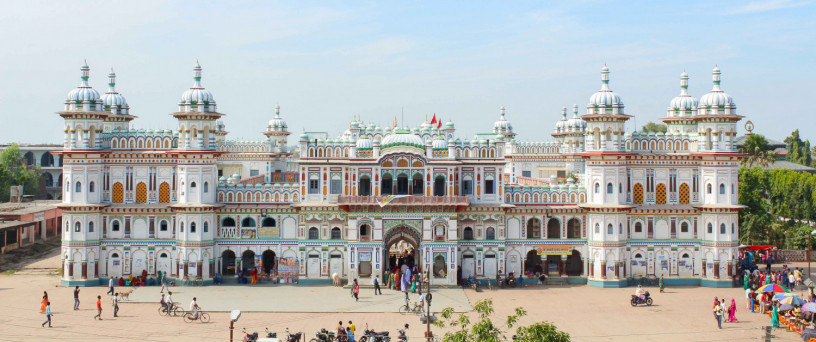Janaki Temple: A Sacred Jewel in Nepal's Religious Landscape Professional
Jul 9th, 2024 at 13:09 Blogs Janakpur 73 views Reference: 1377Location: Janakpur
Price: Contact us
The Janaki Temple, also known as the Janaki Mandir, is one of the most significant and beautiful Hindu temples in Nepal. Located in the ancient city of Janakpur in the Mithila region, the temple is dedicated to the goddess Sita, the consort of Lord Rama and a central figure in the Hindu epic, the Ramayana. The temple not only serves as a religious landmark but also as a cultural and architectural marvel that attracts thousands of pilgrims and tourists every year.
Historical Background
The Janaki Temple was built in 1910 AD by Queen Vrisha Bhanu of Tikamgarh, India. It is believed to be constructed on the exact spot where Sita, also known as Janaki, was born and where she was later married to Lord Rama. This connection to the Ramayana makes Janakpur and the Janaki Temple significant pilgrimage sites for Hindus from Nepal, India, and beyond.
Architectural Grandeur
The Janaki Temple is a stunning example of Hindu-Koiri Nepali architecture, which blends classical Indian styles with local Nepali elements. The temple is constructed primarily of marble and stone, with intricate carvings and vibrant colors adorning its façade. Key features of the temple include:
1. Main Temple Structure
The main temple is a three-storied building with 60 rooms, each intricately decorated with colorful glass, engravings, and paintings. The temple's high domes and beautiful arches are reminiscent of Mughal and Rajput architectural styles.
2. Central Shrine
The heart of the Janaki Temple is the sanctum sanctorum, which houses the idol of Goddess Sita. The central shrine is a place of deep reverence and devotion, where pilgrims offer prayers and seek blessings.
3. Vivah Mandap
Adjacent to the main temple is the Vivah Mandap, a pavilion that commemorates the divine marriage of Sita and Rama. This structure is especially significant during the annual Vivah Panchami festival, which celebrates the wedding of the divine couple.
4. Beautiful Courtyards and Gardens
The temple complex includes well-maintained courtyards and gardens, providing a serene environment for meditation and reflection. The peaceful surroundings enhance the spiritual experience for visitors.
Religious Significance
Janaki Temple holds immense religious importance for Hindus, as it is directly associated with the life and legend of Sita. It is believed that King Janak, Sita's father, found her as an infant in a furrow in the field while plowing. This miraculous discovery and her subsequent marriage to Lord Rama form the core of many devotional practices and stories.
The temple is a focal point for numerous religious festivals and rituals. The most notable among them is Vivah Panchami, celebrated in November-December, which marks the anniversary of Sita and Rama's wedding. During this festival, Janakpur comes alive with processions, reenactments of the wedding, and a large influx of pilgrims.
Cultural and Social Impact
The Janaki Temple is not only a religious site but also a cultural hub that showcases the rich traditions of the Mithila region. The temple's art and architecture reflect the area's unique cultural heritage. Moreover, Janakpur itself is a center for Maithili art and culture, with the temple playing a crucial role in preserving and promoting these traditions.
The influx of pilgrims and tourists has also had a significant impact on the local economy, fostering hospitality and tourism-related businesses. The temple acts as a bridge between Nepal and India, strengthening cultural and religious ties between the two countries.
Preservation and Maintenance
Maintaining the grandeur of the Janaki Temple is a continuous effort. Local authorities, along with various religious organizations, have been actively involved in the preservation and upkeep of the temple complex. Restoration projects are undertaken regularly to ensure that the temple retains its splendor and remains accessible to future generations.
Visiting Janaki Temple
For those planning a visit, Janakpur is well-connected by road and air. The best time to visit is during major festivals, particularly Vivah Panchami, to witness the temple in all its festive glory. Visitors are advised to respect local customs and traditions, ensuring a harmonious and enriching experience.
Conclusion
The Janaki Temple is a beacon of spiritual devotion, architectural beauty, and cultural richness. Its historical and religious significance, coupled with its stunning architecture, make it a must-visit destination for anyone interested in the spiritual and cultural heritage of Nepal. As a symbol of divine love and devotion, the Janaki Temple continues to inspire and attract people from all walks of life, fostering a deeper appreciation for the timeless traditions of the Ramayana.


